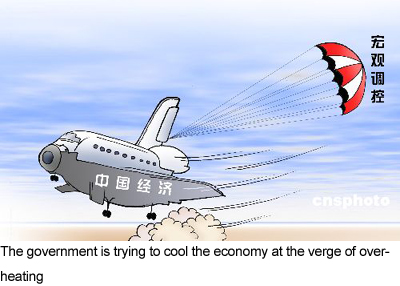In 2007 the Chinese economy was in danger of excessive liquidity
and high inflation. The central government enacted a series of
measures to balance the economy. But the trade surplus still
rocketed and consumer prices still soared. Relatively high
inflation was the end result.
The World Bank predicted that China's trade surplus would hit
US$378 billion in 2007, accounting for 11.9 percent of the GDP as
compared to 2004, when the figure was only US$69 billion, or 3.6
percent of the GDP. A huge trade surplus plus constantly increasing
foreign direct investment has brought in a large amount of foreign
currency. As a result, China's foreign exchange reserves soared to
US$1,400 billion by September 2007, making it the largest in the
world and accounting for 25 percent of the world's total. The
reserves were also 44 percent of China's GDP.
Meanwhile, increased foreign exchange reserves enlarged China's
money base. In order to stabilize the foreign exchange rate, the
central bank had to interfere with the foreign exchange market by
buying in US dollars and issuing RMB. At the same time, the
increasing number of RMB added more liquidity to the market. The
central bank, therefore, had to take currency hedging measures in
order to freeze excessive parts of the currency to keep the
currency growth rate proportionate to that of the economy.
Currently the Chinese financial sector still overflows with liquid
capital, driving consumer prices, housing prices and share prices
up and up.
In retrospect, Chinese inflation has been kept at very low
levels since the mid-1990s. Yu Yongding, Director of the Institute
of World Economics and Politics under the Chinese Academy of Social
Sciences, said that it was a miracle China maintained its economic
growth at over 10 percent while keeping inflation under 3 percent
during the past 4 consecutive years. Some people even took it for
granted that 2007 would be the fifth year (starting from 2003) for
China to witness high economic growth with low inflation. People
believed that the central bank had the ability to offset the impact
that huge foreign exchange reserves would make on the money base.
The reality, however, was quite different from their
expectations.
 |
In November, the consumer price index (CPI) hit a decade high
and jumped by 6.9 percent. Meanwhile, pork prices had been
increasing for 8 weeks consecutively as of November. Pork then
pushed the prices of other foodstuffs to a higher level. Even
worse, rising consumer prices promoted inflation fears. Threatened
by the prospects of high inflation, people invested their savings
in the real estate market and thus further expanded property
bubbles. Yu Yongding expressed his concern in an article warning
that the Chinese macro-economy now depicts a dangerous scenario – a
rising inflation rate co-existing with increasing property
prices.
Fortunately, the central government has been paying careful
attention to these kinds of economic problems. The latest central
economic work conference lasting from December 3 to 5 set two
priorities for the 2008 economic work – to prevent the economy from
overheating and to curb inflation. To reach these goals, the
conference decided to continue following a prudent fiscal policy
but to adopt a tight monetary policy. This means that the
government's public expenditures will stay stable but the currency
supplies will be tightened in 2008.
Zhou Xiaochuan, chief of the central bank, said
that the most demanding task in 2007 was deciding how to prevent
the economy from overheating and to ease the pressure caused by
consumer price hikes via a prudent monetary policy. In 2007, China
raised interest rates five times and the reserve ratio 10 times.
Zhou even stated that to some extent, China's monetary policy was
racing with the pace of the globalization.
In addition, there is an interesting phenomenon in the Chinese
economy. Since 2001, the proportion of household savings in
citizen's disposable incomes has been increasing instead of
falling. This means that compared with the growth of potential and
actual production outputs, the domestic demand growth has been
suppressed rather overheated. Given this, the biggest challenge
that the Chinese economy faced in 2007 was limited domestic
demands. The biggest question about the Chinese economy is not
whether it can maintain its rapid growth but whether it can change
its growth momentum from exports and energy-intensive production to
domestic consumption, both public and private.
(China.org.cn by Pang Li, January 3, 2008)